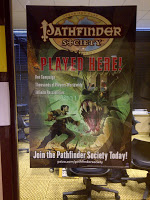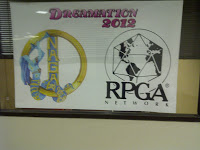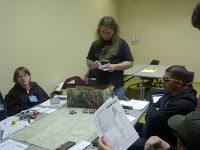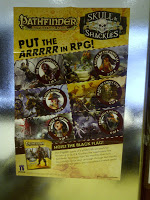 For my final thoughts inspired by this year’s Dreamation convention, I wanted to pay a little attention to the way that companies view and deal with the people who play their games. This was a subject that was talked about at some length in the seminars run by Scott Douglas, both in the specific realm of organized play and the more general realm of companies growing their revenue streams.
For my final thoughts inspired by this year’s Dreamation convention, I wanted to pay a little attention to the way that companies view and deal with the people who play their games. This was a subject that was talked about at some length in the seminars run by Scott Douglas, both in the specific realm of organized play and the more general realm of companies growing their revenue streams.
 Scott, having been head of the RPGA for quite some time, naturally has some great insights into that aspect of the hobby/industry. He stressed the point that having an organized play structure in place is exceedingly helpful for companies not only to market their own games, but to grow the market by bringing in fresh players.
Scott, having been head of the RPGA for quite some time, naturally has some great insights into that aspect of the hobby/industry. He stressed the point that having an organized play structure in place is exceedingly helpful for companies not only to market their own games, but to grow the market by bringing in fresh players.
Note, however, that just having that infrastructure isn’t enough. You have to know what to do with it. One of the things I found most striking at this convention was the comparison between how the RPGA was represented and how the Pathfinder Society was.
 I found the difference between the two quite illuminating. While both Pathfinder Society and Living Forgotten Realms were well-represented in the schedule, I found the Pathfinder Society to do an overall better job of representing the flag. They had colorful posters with good art around the gaming hall that not only advertised their own group, and Pathfinder in general, but specific adventures as well. The RPGA had a white oversized printout that they shared with another, local-but-aspiring-to-more group called NAGA.
I found the difference between the two quite illuminating. While both Pathfinder Society and Living Forgotten Realms were well-represented in the schedule, I found the Pathfinder Society to do an overall better job of representing the flag. They had colorful posters with good art around the gaming hall that not only advertised their own group, and Pathfinder in general, but specific adventures as well. The RPGA had a white oversized printout that they shared with another, local-but-aspiring-to-more group called NAGA.
The Pathfinder Society GMs were easy to spot; they all wore shirts that clearly identified who they were and what they were playing. The RPGA GMs, not so much. I don’t have a dog in the Pathfinder-4E race, but my own impression was that the Pathfinder Society folks were better organized, better supported from their home base, and more enthusiastic than their RPGA counterparts.
How does this translate into sales, or growth in players? Well, hard numbers are difficult to come by, but according to the latest survey of retail stores by Purple Pawn, Pathfinder is far outstripping 4E in terms of sales. That’s in line with other industry estimates that have been coming out over the last year or two. I certainly won’t say that it all has to do with the way they are handling their organized play arms, but it certainly couldn’t be hurting that the Pathfinder Society seems more energetic, confident, and supported, and Pathfinder is doing better in retail stores.
There is one thing of which I am not certain, since I’m not a Pathfinder player myself (although I am on record as saying I think Paizo is doing everything right in terms of how to run a game company viz-a-viz their fan base) is how Pathfinder compares in in-store play as opposed to conventions. Do they have anything comparable to the WotC Lair Assault program? I’d be curious as to what other people’s experiences with organized play, either with RPGA, Pathfinder Society, C&C Society, etc. has been. Do your observations square with mine, or have you had a very different experience?











I played a few Pathfinder society games at Gen Con this year and found them to be…adequate. One adventure good, one was bad, and one was boring. None of the GMs were particularly animated or engaged and one was either showing favoritism or just inadvertently allowing a couple of players to hog the spotlight. The game space was a noisy, cramped room of back to back tables like you always seem to see for those kinds of events – a necessary evil of the con.
Organizationally, they were head and shoulders above the RPGA in terms of enthusiasm and con presence. I wouldn't have known the RPGA was there at all if i didn't know that the RPGA is always there, but the Pathfinder Society seemed to have their full-color posters all over the place and were actively recruiting new players.
In the end, i'm not really a fan of either group. I think they both make their respective games boring with lowest-common-denominator-adventures and by focusing too heavily on "living" campaigns. (All the frustrations of a home game and all the annoyances of a Con game rolled into one, with the benefits of neither!)
While I'm not precisely sure on the logistics of it, I think a small-scale community run corpus of "live" style games could work. I know that everyone hates the live variations that were run in FR and Greyhawk respectively, but I don't think that is an inherent problem with the notion of a live game so much as with the methodology of the RPGA.